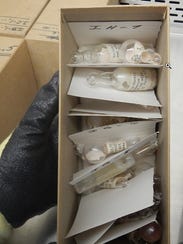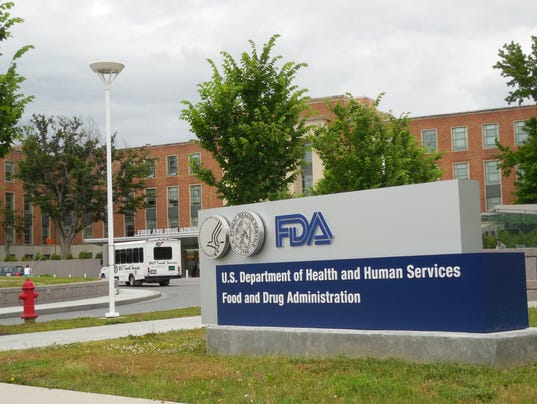Strict Standards: Only variables should be assigned by reference in /home/noahjames7/public_html/modules/mod_flexi_customcode/tmpl/default.php on line 24
Strict Standards: Non-static method modFlexiCustomCode::parsePHPviaFile() should not be called statically in /home/noahjames7/public_html/modules/mod_flexi_customcode/tmpl/default.php on line 54
Strict Standards: Only variables should be assigned by reference in /home/noahjames7/public_html/components/com_grid/GridBuilder.php on line 29
Laboratories operated by the U.S. Food and Drug Administration lack key data for tracking safety incidents, fail to require important training and need to establish more consistent procedures, according to a report by outside experts examining federal biolabs in the wake of high-profile mishaps with deadly pathogens.
The FDA Is addressing the issues by hiring a top safety official, improving training and taking several other actions, said Luciana Borio, the agency’s acting chief scientist. The FDA’s scientists do research with bacteria and viruses that cause food-borne illnesses as well as those with potential to be used as bioweapons as part of the agency's work regulating a wide range of products.
“I thought the report was extraordinarily important for us,” Borio said Wednesday. The agency has a “tremendous commitment” to improving safety and putting new agency-wide training and specimen inventory programs in place by next year, she said.
In the summer of 2014 forgotten vials of the virus that causes smallpox — a deadly disease that has been eradicated globally — and other dangerous pathogens were discovered in an FDA storage room on the campus of the National Institutes of Health in Bethesda, Md. The smallpox virus poses such a significant health threat that under international agreement only two labs in the world are allowed to possess any samples of it: The Centers for Disease Control and Prevention in Atlanta and another lab in Russia.
In addition, a serious string of lab accidents became public last year at the CDC, including one that potentially exposed dozens of that agency’s workers to live anthrax bacteria, as well as other mishaps with specimens of Ebola virus and a deadly strain of avian influenza. Meanwhile an ongoing USA TODAY Media Network investigation has revealed numerous other serious safety and security incidents at labs nationwide operated by other government agencies, universities and private companies.
Since last year, a group of outside lab safety experts has been evaluating biosafety at research facilities operated by the CDC, NIH and FDA, which are all part of the U.S. Department of Health and Human Services. The advisers' report on the FDA’s labs was posted Friday on the agency’s website without any announcement.

Forgotten vials of the deadly Variola virus that causes smallpox were among dozens of vials of pathogens discovered in 2014 in old cardboard boxes in an FDA storage room at the National Institutes of Health. (Photo: House Energy and Commerce Committee)
In a separate examination of labs operated by the NIH, the safety advisers largely offered praise. “The commitment of NIH leadership toward laboratory safety is evident and is demonstrated at all levels examined…” said that report, which was posted online in July, and made several recommendations, including for the NIH to do more to ask scientists to consider alternative methods that might further reduce risks of their research.
Alfred Johnson, the NIH’s director of research services, in an interview Wednesday said NIH was pleased with the report's findings and that the agency has already addressed most of the recommendations. Johnson said that recent lab incidents have prompted greater discussion and collaboration among federal agencies on ways to improve safety.
“Incidents like the ones you mention tend to make people refocus,” he said. “We’re all now committed to making sure we have better safety programs in place.”
In January the safety advisers issued a scathing report on the CDC’s labs, warning that the agency was “on the way to losing credibility,” that staff feared reporting accidents and agency and leadership lacked commitment toward safety. The CDC last week announced it had hired a permanent top official to oversee safety in its labs.
The FDA’s lab safety deficiencies, while not as egregious as what the federal advisers found at the CDC, further illustrate the need for the country to have a single lab safety oversight agency, say some experts.
The Government Accountability Office, the investigative arm of Congress, has repeatedly warned lawmakers since 2007 that there is a lack of national standards for operating high-containment laboratories and that there is no single federal entity responsible for oversight of these kinds of labs, which work with some of the world’s most dangerous viruses, bacteria and toxins.
Richard Ebright, a microbiologist at Rutgers University who has testified before Congress on lab safety issues, said “the reports underscore the fact that there are gaps and inconsistencies in the implementation and enforcement of federal biosafety guidelines, even in federal agencies.”
Ebright said the findings by the advisory group shows “the need to replace the spottily implemented and utterly unenforced current federal biosafety guidelines with uniform and enforced biosafety rules.”
The House Energy and Commerce Committee has held multiple hearings on lab safety problems over the years, including two since the latest string of troubling lab accidents became public beginning in 2014. The incidents have continued this year with the discovery in May that an Army lab had been mistakenly shipping live anthrax samples – instead of fully killed specimens -- to unsuspecting labs for more than a decade.
“There’s no hiding the recent failures of federal agencies to implement appropriate and necessary lab safety standards involving some of the world’s deadliest pathogens,” said U.S. Rep. Fred Upton, R-Mich., the committee’s chairman.
“These repeated blunders have put lives at risk and jeopardized the country’s bioterrorism response efforts,” Upton said. “The committee will continue its due diligence in determining how best to stop this reckless trend, and that includes examining the merits of a single lab oversight agency. One thing is for certain – the status quo that has fostered these mishaps is unacceptable.”

U.S. Rep. Fred Upton, R-Mich., says continued lab safety incidents are unacceptable. (Photo: Carlos Osorio, AP)
The committee’s ranking Democrat, Frank Pallone, Jr. of New Jersey, added: “We continue to have specific concerns that this important area may lack sufficient and coordinated oversight, and we hope to do additional bipartisan follow-up with the relevant stakeholder agencies and GAO to determine how to ensure strong and effective oversight over these important functions.”
Oversight of biological research labs is fragmented, often secretive and largely self-policing, USA TODAY has found. The Federal Select Agent Program – jointly run by the CDC and the U.S. Department of Agriculture, inspects and regulates only a subset of research labs that work with certain pathogens deemed to pose bioterror threats, such as those that cause anthrax, plague, botulism and Ebola. But the regulated pathogens don’t include other dangerous viruses and bacteria – such as deadly strains of influenza and tuberculosis – that need to be worked with in high-containment labs equipped with special safety measures.
Many of the recent lab safety incidents drawing concern have occurred in labs currently regulated by the Federal Select Agent Program, raising questions in Congress about the effectiveness of the program.
At a committee hearing on lab safety in July, Pallone asked the GAO’s director of healthcare, Marcia Crosse, to elaborate on her organization’s longstanding recommendation for establishing a single federal entity to oversee lab safety not just at labs working with “select agent” pathogens, but any microbes that require high-containment safety precautions.
“We continue to believe that such an entity -- or some other mechanism to ensure higher level oversight -- is needed in the face of the continuing proliferation of high-containment laboratories and the ongoing failures by agencies to fix their problems on their own,” Crosse testified.
“We’ve been lucky so far,” Crosse told the committee, referring to recent lab incidents. “If the types of mistakes we’ve seen were to occur with a particularly transmissible pathogen, like certain strains of influenza, not only would the laboratory workers or their close contacts be at risk, an epidemic could be triggered with consequences far beyond what we’ve seen to date.”
The newly released report on FDA’s labs, which is dated July 17, praised how FDA staff responded last year to the discovery of the smallpox vials. “Most importantly, this incident demonstrated that FDA staff feels empowered to report incidents in spite of their potential negative impact,” the report said, also commending the FDA’s plans to develop a centralized electronic inventory system for its labs.
But the report raised concerns about inconsistencies in safety approaches across a wide range of labs operated by multiple, separate divisions within the agency.
“In this environment, (FDA's divisions) have developed important aspects of the research safety program independently, with some safety programs more fully developed than others,” the report said.
In one division, the report said, “staff did not seem to know procedures for whom to call in emergency medical situations.” Consistent training also was lacking, the report said, and "it appears that at some sites important training is not mandatory and that competency assessments (post tests) are not performed."
Staff working in the FDA’s Center for Biologics Evaluation and Research, which is involved in regulation of products such as blood, tissues, and cellular and gene therapies, told the reviewers they felt their safety program works. Yet the report said those working in the agency's Center for Food Safety and Applied Nutrition, which is involved with the safety of the food supply and prevention of microbial and chemical hazards, “indicated a need for a stronger biosafety presence” and more training.
The report said the agency needs to have “concrete data” on lab accidents and incidents so it knows how many accidents have occurred in labs operated by each of its divisions and can identify emerging safety problems. It noted that the NIH has a good system of centralized tracking of incidents.
The co-chairs of the advisory group — Joseph Kanabrocki, associate vice president for research safety at the University of Chicago, and Kenneth Berns, an emeritus professor from the University of Florida — did not respond to interview requests.
Borio said for the first time in the FDA’s history, the agency is in the process of consolidating many of its lab operations onto a large campus in Silver Spring, Md., which will be helpful in creating more uniform approaches to safety.
The FDA also has created a new high-level Director of Laboratory Safety and Security to be the agency’s new central point of accountability and expects to have the position filled in October, she said. A new core curriculum of lab safety training is also being developed, she said.
Read full coverage of USA TODAY's ongoing investigation of safety and security issues at labs across the country: biolabs.usatoday.com
Follow USA TODAY investigative reporter Alison Young on Twitter: @alisonannyoung
Read or Share this story: http://usat.ly/1Kwd3jJ
Strict Standards: Only variables should be assigned by reference in /home/noahjames7/public_html/modules/mod_flexi_customcode/tmpl/default.php on line 24
Strict Standards: Non-static method modFlexiCustomCode::parsePHPviaFile() should not be called statically in /home/noahjames7/public_html/modules/mod_flexi_customcode/tmpl/default.php on line 54
Find out more by searching for it!

